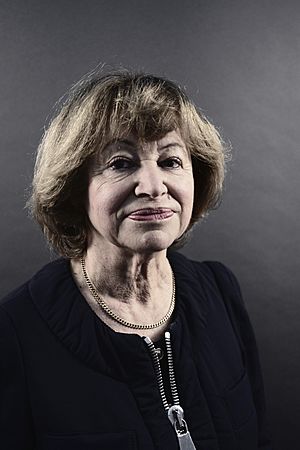Catherine Cesarsky facts for kids
Quick facts for kids
Catherine J. Cesarsky
|
|
|---|---|

Catherine J. Cesarsky
|
|
| Born | 24 February 1943 Ambazac, France
|
| Nationality | Argentinian–French |
| Alma mater | University of Buenos Aires Harvard University |
| Known for | Designing the ISOCAM camera on board the Infrared Space Observatory |
| Awards | COSPAR Space Science Award (1998) Prix Jules Janssen (2009) Tate medal (2020) Fritz Zwicky Prize (2024) |
| Scientific career | |
| Fields | Astronomer |
| Institutions | SKAO Council; European Southern Observatory Germany |
| Thesis | Interactions of Cosmic Rays with Hydromagnetic Waves in the Galaxy (1971) |
Catherine Jeanne Cesarsky, born on February 24, 1943, is a famous astronomer from Argentina and France. An astronomer is a scientist who studies stars, planets, and everything in space. Catherine Cesarsky is well-known for her important research in astrophysics, which is a part of astronomy that uses physics to understand the universe. She is also known for her strong leadership in the fields of astronomy and atomic energy.
Currently, she leads the SKAO Council, which is the main group for the Square Kilometre Array, a huge radio telescope project. She made history as the first woman to be president of the International Astronomical Union (from 2006 to 2009). She was also the first woman to be the Director General of the European Southern Observatory (from 1999 to 2007).
Contents
Early Life and Education
Catherine Cesarsky was born in France but grew up mostly in Argentina. She studied physical sciences at the University of Buenos Aires. In 1971, she earned her PhD in astronomy from Harvard University in the USA. Her PhD research focused on how cosmic rays travel through our galaxy. Cosmic rays are tiny, super-fast particles from space.
A Career in Science Leadership
After getting her PhD, Dr. Cesarsky worked as a researcher at the California Institute of Technology for three years. In 1974, she moved to France and joined the Commissariat à l'Energie Atomique (CEA). This is a French organization that works on atomic energy and other sciences.
Leading Research Teams
From 1985 to 1993, she became the head of the Astrophysics Service at CEA. Later, from 1994 to 1999, she directed the entire Department of Material Sciences. In this role, she led about 3,000 scientists, engineers, and technicians. They worked on many basic research programs in physics, chemistry, astrophysics, and earth sciences.
Directing the European Southern Observatory
From 1999 to 2007, Dr. Cesarsky was the Director General of the European Southern Observatory (ESO). ESO is an organization that builds and operates powerful telescopes. During her time at ESO, the construction of the Very Large Telescope (VLT) was completed. The VLT is a group of telescopes that work together to see very distant objects. She also helped finish agreements and start building the Atacama Large Millimeter Array (ALMA). ALMA is another large telescope that studies cold gas and dust in space. She also began studies for the European Extremely Large Telescope, which will be one of the biggest optical telescopes ever.
Advising the French Government
From 2009 to 2012, she served as the High Commissioner for Atomic Energy in France. She still advises the French government on science and energy topics. She also leads important committees for the French space agency and for a European atomic energy program.
International Astronomical Union
From 2006 to 2009, Dr. Cesarsky was the President of the International Astronomical Union (IAU). This is a global organization for astronomers. She was the first woman ever to hold this important position. In 2017, she became the chairperson for the Square Kilometre Array Organisation. She continues to lead its successor, the SKAO Council, since 2021.
Groundbreaking Research
Dr. Cesarsky is famous for her research in several key areas of astrophysics. Early in her career, she focused on high-energy astrophysics. This included studying how cosmic rays travel and what they are made of. She also looked at how particles speed up in space, for example, near exploding stars called supernovae.
Infrared Astronomy Discoveries
Later, she shifted her focus to infrared astronomy. Infrared light is a type of light that we can't see with our eyes, but it helps scientists study cool objects in space. She was the main scientist for the camera on the Infrared Space Observatory (ISO). This space telescope was launched by the European Space Agency and operated from 1995 to 1998.
With the ISO camera, she led a major project that studied infrared light from many sources in our galaxy and beyond. This research led to exciting new discoveries about how stars form and how galaxies change over time. She continued these studies using other powerful telescopes like the European Southern Observatory's VLT, the Spitzer Space Telescope, and the Herschel Space Observatory.
Awards and Honors
Catherine Cesarsky has received many awards and honors for her contributions to science. She is a member of several important scientific groups, including the Academia Europaea and the International Academy of Astronautics. In 2010, she received an honorary degree from the University of Geneva.
Some of her other awards include:
- 1998 – Recipient of the Committee on Space Research Space Sciences Award
- 2005 – Foreign Associate of the National Academy of Sciences of the United States of America
- 2005 – Foreign Member of the Royal Society of London
- 2007 – Member of the French Academy of Sciences
- 2009 – Prix Jules Janssen from the Société astronomique de France
- 2020 – Tate medal awarded by the American Institute of Physics for leadership
- 2024 – Fritz Zwicky Prize for Astrophysics and Cosmology
Images for kids
See also
 In Spanish: Catherine Jeanne Cesarsky para niños
In Spanish: Catherine Jeanne Cesarsky para niños


